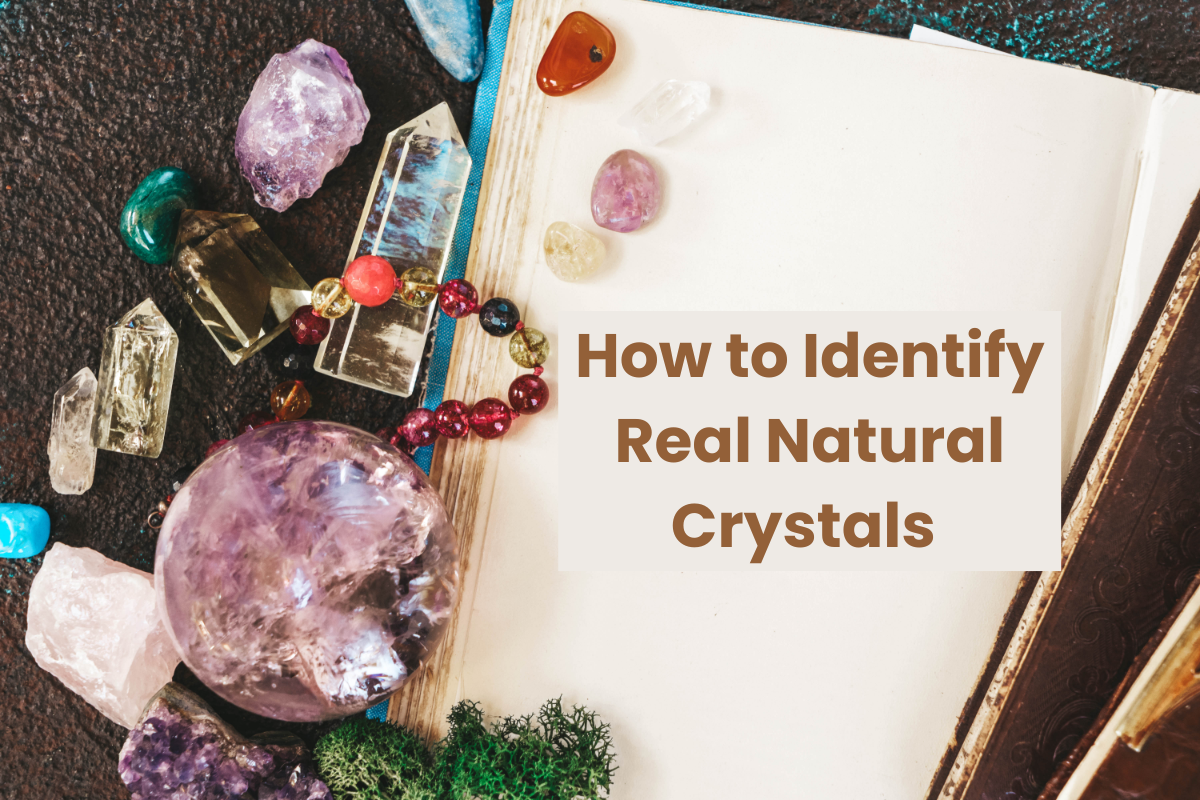With the rising popularity of crystal healing and energy work, the market has been flooded with synthetic and imitation stones. If you’re passionate about collecting crystals for meditation, home décor, or spiritual practice, it’s essential to ensure the stones you bring into your space are the real deal.
This practical guide walks you through how to identify real natural crystals using simple, proven techniques — no special tools required. Whether you're a beginner or a seasoned collector, these methods will help you make informed decisions and avoid fake or altered stones.
Why Authentic Crystals Matter
Natural crystals are formed over millions of years, absorbing the Earth’s energy and patterns. Their unique imperfections, density, and vibration contribute to the healing and energetic benefits many people seek. In contrast, fake crystals — made from glass, plastic, or dyed resins — lack these energetic properties and can be misleading, especially in spiritual practices.
Let’s explore 8 simple and effective ways to verify if your crystal is natural and authentic.
1. Look for Natural Imperfections
What to Check: Real crystals often have inclusions, cloudy zones, or tiny fractures. These are part of their natural growth process.
How to Test:
-
Use a magnifying glass or jeweler’s loupe to inspect the surface.
-
Look for small mineral deposits, internal lines, or subtle zoning.
-
Avoid overly flawless or bubble-free pieces — these are common in glass imitations.
Practical Tip: Natural Amethyst, for instance, often has subtle white bands or gradients, not flat purple coloring.
2. Test the Crystal’s Hardness
What to Check: Every crystal has a known hardness rating. For example, Quartz varieties like Amethyst and Rose Quartz rate 7 on the Mohs scale — they can scratch glass.
How to Test:
-
Try gently scratching a glass surface with the crystal (test discreetly).
-
A real Quartz crystal should leave a mark.
-
Compare with known hardness levels: Calcite is 3, Fluorite is 4, Quartz is 7, and Diamond is 10.
Practical Tip: Don’t test valuable or delicate stones. Use this method only on less expensive pieces.
3. Feel the Temperature
What to Check: Natural crystals are thermal conductors — they feel cool to the touch and warm slowly in your hand.
How to Test:
-
Hold the crystal for 10–15 seconds.
-
A genuine crystal will stay cool longer than glass, resin, or plastic.
Practical Tip: Use this method when browsing in person — it’s quick and intuitive.
4. Assess Weight and Density
What to Check: Natural crystals are denser and heavier than imitations of similar size.
How to Test:
-
Compare the weight in your hand with another stone of similar size.
-
Use a small digital scale if available — real crystals like quartz, citrine, and jasper feel heavier than resin or glass.
Practical Tip: A solid feel often correlates with grounding energy — another benefit of choosing real stones.
5. Examine Clarity and Color Patterns
What to Check: Natural crystals rarely have uniform colors. They may have cloudy areas, internal rainbows, or color zoning.
How to Test:
-
Hold the crystal up to light — check for gradient coloring or layered inclusions.
-
Be cautious of overly vivid, uniform, or neon colors (like bright turquoise or hot pink).
-
Look for tiny air bubbles — a giveaway of glass.
Practical Tip: Real Citrine often appears pale yellow with smoky zones — bright orange ones are usually heat-treated or dyed Amethyst.
6. Inspect Crystal Growth Patterns
What to Check: True crystals grow in natural geometric formations, such as hexagonal prisms, terminations, or layered patterns.
How to Test:
-
Use a loupe to inspect terminations and surface textures.
-
Look for striations (growth lines), not mold lines or poured resin patterns.
-
Check for natural fractures along edges rather than smooth, rounded finishes.
Practical Tip: Points or wands should have naturally sharp or imperfect terminations. Molded or sanded ends are a red flag.
7. Use a UV Light Test (Optional Bonus)
What to Check: Some crystals, like Fluorite or certain Calcites, fluoresce under UV light.
How to Test:
-
In a dark room, shine a UV light on the stone.
-
Real Fluorite often glows blue, green, or violet.
-
Lack of fluorescence doesn’t mean it’s fake — not all crystals have this trait.
Practical Tip: Use this method as a bonus tool, especially for known fluorescing types.
8. Verify the Seller and Source
What to Check: Ethical and knowledgeable sellers are transparent about sourcing, treatments, and authenticity.
How to Test:
-
Research the seller's reviews and reputation.
-
Ask about origin (e.g., Brazil, Madagascar, Pakistan).
-
Look for disclaimers on treated, dyed, or lab-grown stones.
Practical Tip: Build relationships with trusted crystal shops and always ask questions — a good seller won’t mind.
🌿 Bonus: Common Fake Crystals to Watch For
| Fake Type | Often Sold As | Red Flags |
|---|---|---|
| Dyed Glass | Amethyst, Quartz, “Aura” | Too vibrant, bubble-filled, no natural zoning |
| Dyed Howlite/Resin | Turquoise, Malachite | Perfect pattern repetition, light feel |
| Synthetic Quartz | Quartz, Citrine | Flawless clarity, low vibration |
🧼 Caring for Real Crystals
Once you’ve identified and collected real crystals, keep their energy clean and vibrant.
-
Cleanse regularly with sage, sound, or moonlight.
-
Store safely, especially soft stones like Selenite.
-
Set intentions to align your crystal’s energy with your goals.
Conclusion: Trust the Earth, Trust Your Intuition
Real natural crystals aren’t perfect — they’re beautifully flawed, energetically rich, and full of Earth’s memory. By using these simple tests and mindful sourcing practices, you can build a powerful, authentic crystal collection that supports your energy and intention.
Whether you're drawn to the clarity of Quartz, the calm of Amethyst, or the warmth of Citrine — let your crystals reflect the real you.

Share:
How to Choose the Perfect Crystal for Your Needs: A Beginner’s Guide
10 Essential Crystals for Beginners: A Complete Guide to Crystal Healing